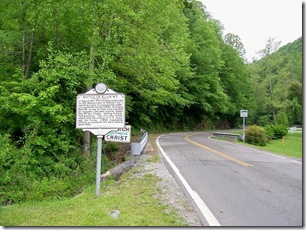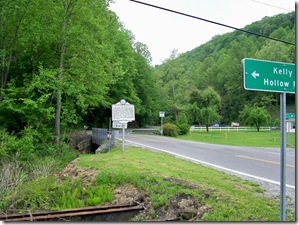Marker Text: In August of 1921, 7000 striking miners led by Bill Blizzard met at Marmet for a march on Logan to organize the southern coalfields for the UMWA. Reaching Blair Mt. on August 31, they were repelled by deputies and mine guards, under Sheriff Don Chafin, waiting in fortified positions. The five-day battle ended with the arrival of U. S. Army and Air Corps. UMWA organizing efforts in southern WV were halted until 1933. "
Location: On WV Route 17, approximately 8 miles east of Logan between Ethel and Blair, WV. Erected by WV Celebration 2000, West Virginia Division of Archives and History in 2002.
From 2002-2008, I lived in Logan County, WV and I often heard of the stories about the Battle of Blair Mountain from local residents. From the mid-1800's residents in the area knew coal existed in the mountains of Logan County, but it was not until the railroad came to the county in 1904 was it possible to mine the coal for commercial use. Once the railroads made it possible to remove the coal to needed markets the coal business in Logan County took off and the population increased with men seeking employment in the coal mines.
Prior to the construction of the four lane highway, U.S. Route 119 (or as the locals call it Corridor G) from Logan to Charleston, WV, the only way to travel to Charleston was to go over Blair Mountain on WV Route 17. Traveling over Blair Mountain is not the most difficult mountain road crossing a person can make in West Virginia, but you definitely know you are going over a mountain as you travel the road.
Photo taken looking south on Route 17 toward Logan County. This is where you would go up Blair Mountain from the north. Click any photo to enlarge.
The details about the Battle of Blair Mountain, including the events in the coal mines that lead to this confrontation, the lives of the miners, the struggle for unions and the political conditions at the time are so extensive, I cannot possibility cover them in my post on this marker. So I will only give a general description of the events here. If you want to learn more a simple search on the internet, using a search engine, like Google or Bing will give you many links about the details with many interesting photos. A web site by the West Virginia Archives and History has several links to articles about the Battle of Blair Mountain.
The Battle of Blair Mountain was the largest armed uprising in American history since the U.S. Civil War. From August to September 1921, armed coal miners from the Kanawha Valley and the southern counties of Boone, Fayette, Mingo, McDowell, and Logan gathered at Marmet in Kanawha County. The miners proposed to march to Logan and Mingo counties to rescue union miners who had been jailed or mistreated in attempts to unionize the West Virginia mines. Their efforts brought on the most spectacular confrontation in West Virginia’s labor history, the culminating event in the era known as the Mine Wars with this confrontation being termed the Red Neck War, from the color of bandannas worn by the miners around their necks and the origin of the term “Red Neck.”
Though tensions had been simmering for years, the immediate cause for the Battle of Blair Mountain was the unpunished murder of Sid Hatfield, police chief of Matewan, WV (in Mingo County) on the steps of the McDowell County courthouse in Welch in July 1921 by agents of the Baldwin-Felts private detective agency. Hatfield had been a long-time supporter of the United Mine Workers of America (UMWA) and their efforts to unionize the mines.
Another view of the marker looking south on Route 17 toward Blair Mountain.
The marker states that 7,000 miners were involved but other sources estimate the numbers participating anywhere between 7,000 to 20,000. Many miners were veterans of World War I, and they organized themselves like an army division. The marchers had medical and supply units, posted guards when appropriate, and used passwords to weed out infiltrators. Marchers commandeered trains and other vehicles to take them to Logan County (though the trains could only take them to Madison, since no trains went over Blair Mountain) and confiscated supplies from company stores along the march.
Meanwhile, the reviled and anti-coal union Sheriff of Logan County, Don Chafin had begun to set up defenses on Blair Mountain. Chafin was supported by the Logan County Coal Operators Association. Also state officials, led by WV Governor Morgan, quickly organized a group of state police, volunteer militia companies, and coal company employees to keep the miners from invading Logan County. Chafin was a bitter foe of union organizers and with financial support from coal companies, used his many deputies to keep labor organizers out of Logan County. United Mine Workers of America members hated Don Chafin so much, it is reported that he was shot on sight and wounded when entering UMWA District 17 headquarters in 1919.
The area for the battle comprised about a 1,600 acres. The first skirmishes occurred on the morning of August 25. The bulk of the miners were still 15 miles away. By August 29, the two side were fully engaged in battle. Chafin's men, though outnumbered, had the advantage of higher positions and better weapons. Sporadic gun battles continued for a week, with the miners at one time nearly breaking through to the town of Logan and their target destinations and the non-unionized counties to the south, Logan and Mingo.
West Virginia Governor Morgan urgently requested federal intervention to end the bloodshed. President Warren G. Harding responded with 2,500 federal troops, including a bomber squadron under aviation pioneer Gen. William ‘‘Billy’’ Mitchell. By September 2, federal troops had arrived. Many of the miners being veterans themselves refused to fire upon U.S. troops, which helped to end the conflict. The federal troops quickly brought the conflict to an end and the miners returned home. Up to 30 deaths were reported on both sides, with many hundreds more injured, though estimates of the number of deaths and injuries are difficult to determine.
Following the battle, 985 miners were indicted for "murder, conspiracy to commit murder, accessory to murder, and treason against the State of West Virginia." Though some were acquitted by sympathetic juries, many were also imprisoned for a number of years, though they were paroled in 1925. Most were given minor sentences, but serious attempts were made to punish William ‘‘Bill’’ Blizzard, one of the march leaders, who was charged with treason.
On May 27, 1922, William Blizzard, UMWA official was indicted for his role in the Armed March on Logan, was found not guilty of treason in Jefferson County. During his trial in Charles Town, WV, an unexploded pipe bomb was used as evidence of the government and companies' brutality and ultimately resulted in his acquittal.
In the short term, the battle seemed to be an overwhelming victory for coal mine operators and UMWA membership plummeted over the next several years. It was not until 1935 was the UMW successfully organized in southern West Virginia, after the election of Franklin Delano Roosevelt.
In 2006, the National Trust for Historic Preservation designated Blair Mountain as one of the country’s “Most Endangered Historic Places.” The National Park Service added Blair Mountain to its National Register of Historic Places in March 2009. Nine months later the park service reversed its decision following a dispute about property ownership on the mountain. It is my understanding that a coal company owns the mountain and wants to begin mountaintop removal mining on the site removing any traces of the battle that occurred here. So in a way the Battle for Blair Mountain still continues today.



No comments:
Post a Comment